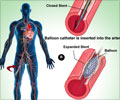Among black people, neither HDL (good cholesterol) measurement was significantly associated with heart attack, revealed UT Southwestern scientists.

‘According to the Centers for Disease Control and Prevention, heart disease is the leading cause of death in the U.S. More than 12 percent of adults in the U.S. have high total cholesterol levels, and more than 18 percent have what's currently considered low levels of HDL cholesterol.’





"Previous studies have looked at HDL levels in the population as a whole," says Anand Rohatgi, M.D., an associate professor of internal medicine at UTSW. "But we know that sometimes biology differs by gender and race, so we thought it was important to separately tease apart what's happening in those populations, as well as how HDL is associated with stroke, which has been understudied." Cholesterol is a waxy substance that is used by the body to make hormones and keep cells functioning properly. But when low-density lipoprotein (LDL) cholesterol levels are too high, cholesterol can accumulate inside blood vessels, forming deposits called plaques. These plaques can eventually lead to blood vessel blockages that cause heart attacks or strokes.
HDL cholesterol helps remove cholesterol from blood vessels. But recent studies have come to mixed conclusions about the association between HDL cholesterol levels and health outcomes.
For the new paper, published in the journal Circulation, Rohatgi and his colleagues pooled together information on people who had participated in four large, nationwide studies - the Dallas Heart Study, Atherosclerosis Risk in Communities study, Multi-Ethnic Study of Atherosclerosis, and the Prevention of Renal and Vascular Endstage Disease study. In all, the studies included 15,784 people followed over an average of 8 to 12 years. Of the participants, 54 percent were male, 22 percent were black, and their average age was 56 years.
"By combining all these large existing cohorts, we had enough numbers to look at these populations that had been understudied in the past," says Kavisha Singh, M.D., a research fellow in cardiology at UTSW and first author of the new study.
Advertisement
In the study, people with the highest HDL-P levels, above 37 mmol/L, had a 37 percent lower risk of heart attack and a 34 percent lower risk of stroke than those who had the lowest HDL-P levels. In women, this association was stronger - those with the highest HDL-P levels had a 49 percent reduction in heart attacks and 46 percent reduction in stroke. While HDL-C predicted heart attack risk in the overall pool of people as well as in women, it was not associated with stroke. When the researchers homed in on black participants, the results were different - neither HDL-C nor HDL-P was linked to a black person's risk of heart attack.
Advertisement
A better understanding of how HDL can help predict disease, and how that association varies among populations, is vital to lowering rates of cardiovascular disease, the researchers say.
"These risk markers are really relevant in everyday primary care and cardiology," says Singh. "Doctors use cholesterol levels to make decisions like whether a patient goes on medication or not."
The team is planning future studies on the functionality of HDL particles among black people, how HDL-P may be used clinically, and whether HDL-P might be associated with specific subtypes of strokes.
Source-Eurekalert















